

Introduction ('Home')
Construction Phase
General Photographs
Daub-making Photographs
Pot Furnace Photographs
Tank Furnace Photographs
Annealing Oven Photographs
We began building the furnaces in February 2005 on a part-time basis, with the aim of completing them in time for lighting in late April. By late March and by then working on them full-time, the firing chambers were built and the superstructures had risen to pot/tank level.
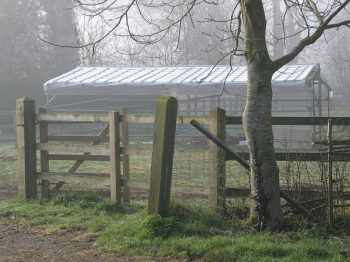
Once the firing chambers had been lined with tiles, progress was quicker. The walls of the superstructures were made from a clay, sand and hay mix and built into domed structures.
The main structures were finished by the third week of April. By the end of the month the thermocouples had been fitted and the various covers and doors were ready.
Although these furnaces had been carefully planned, we found that we adapted these plans as building progressed.
Both furnaces were lit on 26th April, and the reports and photographs for the rest of the project can be accessed from here.
This furnace was based on the ground plans of rounded furnaces with horizontal stoke hole entrances such as have been found in France (see photographs of furnaces found at Cesson-Sévignés and Troyes - from Foy and Nenna).
The firing chamber is tile- or stone-lined and has a floor usually surfaced with large tiles.
There is no evidence for an inner lining of clay daub, so we only applied a thin skin to fill any holes left during the construction.
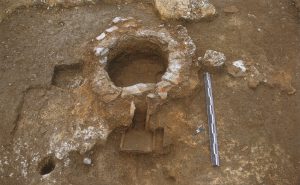
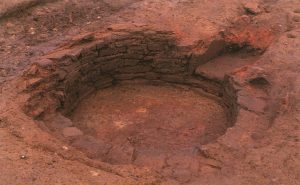
The shelf (siege) for the pots is the top of the firing chamber wall which was corbelled inwards. There is no direct evidence for this method of constructing a siege, but the pots have to sit on something! One of the furnaces excavated at Lyons, France (La Manutention 3 - see photograph and drawing below - from Foy and Nenna) does have a small section of above ground wall which corbels inwards. The pots that rested on this shelf were based on a pot found at the late Roman glassworking site of Hambach Forest, near Cologne (see Gaitzsch, et al).
|
The pots (see photographs on the right) have been covered with a layer of daub. The reason was to try to lengthen their life by effectively increasing their wall thickness. A hairline crack in one of the pots prompted us to do this. There is evidence of a similar process on fragments of Roman pots in the form of a glazed clay(?) layer on the outer surface (see Gaitzsch, et al).
|
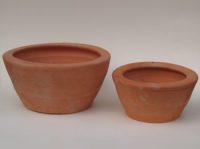
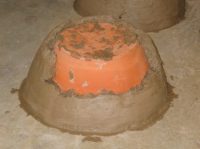
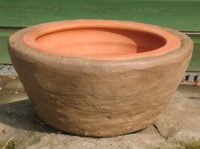
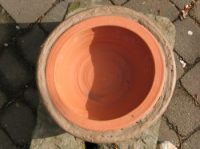
|
The pot chamber was a domed structure entirely composed of a clay/sand/hay daub, with two gathering holes and two smaller holes let into it for reheating small items. The advantages of daub was that the structure could be shaped as needed as it was being built and it formed a strong monolithic structure when dried and fired.
Although there are an increasing number of Roman glassworking sites being identified, there is very little in situ superstructure and the evidence for pots in the earlier Roman furnaces is scarce. For this reason, other ways of holding the molten glass have to be considered. The tank furnace is the alternative.
One method of creating a tank furnace is based on evidence from London in the form of a large tile with a layer of glass which appears to have been inserted into the wall of a furnace and had sidewalls built around it to create the tank (see Allen).
We decided on a similar approach, but using unfired daub with a high proportion of clay to build the tank. This should have removed the problem of unfired clay pulling away from a fired clay tile, avoiding the formation of gaps which would allow the glass to escape (but see this page and this page!).
As with the pot furnace, the firing chamber was built using tiles, but also incorporated stone. The ground plan was oval, a type seen on many sites such as at Lyons (La Manutention 4 - see photograph - from Foy and Nenna), and the stoke hole had an inclined chute, often the case with furnaces such as those found at Augst, Switzerland. The superstructure was built from daub.
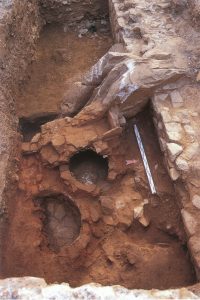
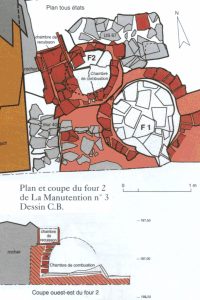
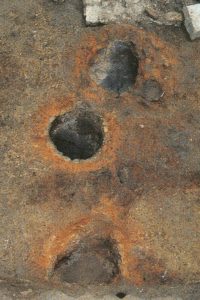
This furnace also had an annealing oven attached which used waste heat from the furnace to heat it. Remains of a similar arrangement is seen on the furnace from Lyons (see photograph and drawing).
"If you build it, they will come."